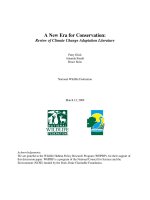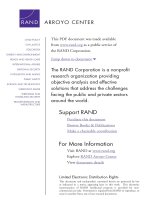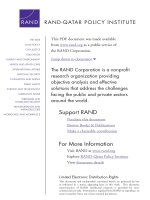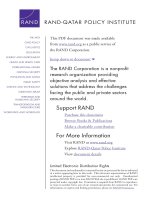Beyond Close Air Support - Forging a New Air-Ground Partnership pptx
Bạn đang xem bản rút gọn của tài liệu. Xem và tải ngay bản đầy đủ của tài liệu tại đây (2.21 MB, 216 trang )
This PDF document was made available
from www.rand.org as a public service of
the RAND Corporation.
6
Jump down to document
Visit RAND at www.rand.org
Explore RAND Project AIR FORCE
View document details
This document and trademark(s) contained herein are protected by law
as indicated in a notice appearing later in this work. This electronic
representation of RAND intellectual property is provided for non-
commercial use only. Permission is required from RAND to reproduce, or
reuse in another form, any of our research documents.
Limited Electronic Distribution Rights
For More Information
CHILD POLICY
CIVIL JUSTICE
EDUCATION
ENERGY AND ENVIRONMENT
HEALTH AND HEALTH CARE
INTERNATIONAL AFFAIRS
NATIONAL SECURITY
POPULATION AND AGING
PUBLIC SAFETY
SCIENCE AND TECHNOLOGY
SUBSTANCE ABUSE
TERRORISM AND
HOMELAND SECURITY
TRANSPORTATION AND
INFRASTRUCTURE
The RAND Corporation is a nonprofit
research organization providing
objective analysis and effective
solutions that address the challenges
facing the public and private sectors
around the world.
Purchase this document
Browse Books & Publications
Make a charitable contribution
Support RAND
This product is part of the RAND Corporation monograph series.
RAND monographs present major research findings that address the
challenges facing the public and private sectors. All RAND mono-
graphs undergo rigorous peer review to ensure high standards for
research quality and objectivity.
Bruce R. Pirnie, Alan Vick, Adam Grissom,
Karl P. Mueller, David T. Orletsky
Prepared for the United States Air Force
Approved for public release; distribution unlimited
Beyond Close
Air Support
Forging a New Air-Ground Partnership
The RAND Corporation is a nonprofit research organization providing
objective analysis and effective solutions that address the challenges
facing the public and private sectors around the world. RAND’s
publications do not necessarily reflect the opinions of its research clients
and sponsors.
R
®
is a registered trademark.
© Copyright 2005 RAND Corporation
All rights reserved. No part of this book may be reproduced in any
form by any electronic or mechanical means (including photocopying,
recording, or information storage and retrieval) without permission in
writing from RAND.
Published 2005 by the RAND Corporation
1776 Main Street, P.O. Box 2138, Santa Monica, CA 90407-2138
1200 South Hayes Street, Arlington, VA 22202-5050
201 North Craig Street, Suite 202, Pittsburgh, PA 15213-1516
RAND URL: />To order RAND documents or to obtain additional information, contact
Distribution Services: Telephone: (310) 451-7002;
Fax: (310) 451-6915; Email:
Library of Congress Cataloging-in-Publication Data
Beyond close air support : forging a new air-ground partnership / Bruce R. Pirnie
[et al.].
p. cm.
Includes bibliographical references.
“MG-301.”
ISBN 0-8330-3741-2 (pbk.)
1. Close air support. 2. Military doctrine—United States. 3. United States. Air
Force. I. Pirnie, Bruce, 1940–
UG700.B48 2005
358.4'142—dc22
2004030608
The research described in this report was sponsored by the United States
Air Force under Contract F49642-01-C-0003. Further information may
be obtained from the Strategic Planning Division, Directorate of Plans,
Hq USAF.
iii
Preface
Although airmen have been providing close air support (CAS) to
friendly ground forces since World War I, recent operations in Af-
ghanistan and Iraq have brought renewed attention to the unique
demands of this mission. The Army increasingly views air power as
indispensable to its future warfighting concepts and seeks mecha-
nisms to ensure that it is available and responsive to the needs of the
land forces. For the Air Force, counterland operations are becoming
more important, but airmen remain concerned with ensuring that air
power’s unique ability to mass rapidly is not lost in efforts to provide
on-call fires to small ground elements spread across a large battle
space.
To address these and related policy challenges, Project AIR
FORCE conducted a study of close support on the future battlefield.
The study addressed three major policy questions: (1) How should air
attack and ground maneuver be integrated? (2) How should the CAS
terminal attack control function be executed? (3) How should ground
maneuver/fires and air attack be deconflicted? This research builds on
work done in Project AIR FORCE over the past ten years to provide
a better understanding of the air-ground partnership as well as to en-
hance the Air Force contribution in operations against enemy land
forces. Previous RAND reports in this area include:
• The Stryker Brigade Combat Team: Rethinking Strategic Respon-
siveness and Assessing Deployment Options, by Alan Vick, David
T. Orletsky, Bruce Pirnie, and Seth G. Jones, MR-1606-AF,
2002.
iv Beyond Close Air Support: Forging a New Air-Ground Partnership
• Aerospace Operations Against Elusive Ground Targets, by Alan
Vick, Richard M. Moore, Bruce Pirnie, and John Stillion,
MR-1398-AF, 2001.
• Aerospace Operations in Urban Environments: Exploring New
Concepts, by Alan Vick, John Stillion, Dave Frelinger, Joel S.
Kvitky, Benjamin S. Lambeth, Jefferson P. Marquis, and
Matthew C. Waxman, MR-1187-AF, 2000.
• Enhancing Airpower’s Contribution Against Light Infantry Targets,
by Alan Vick, John Bordeaux, David T. Orletsky, and David A.
Shlapak, MR-697-AF, 1996.
The research reported here was sponsored by the Director of
Operational Planning, Headquarters, U.S. Air Force, and was con-
ducted within the Strategy and Doctrine Program of RAND Project
AIR FORCE.
RAND Project Air Force
RAND Project AIR FORCE (PAF), a division of the RAND Corpo-
ration, is the U.S. Air Force’s federally funded research and develop-
ment center for studies and analyses. PAF provides the Air Force with
independent analyses of policy alternatives affecting the development,
employment, combat readiness, and support of current and future
aerospace forces. Research is conducted in four programs: Aerospace
Force Development; Manpower, Personnel, and Training; Resource
Management; and Strategy and Doctrine. The research reported here
was prepared under contract F49642-01-C-0003.
Additional information about PAF is available at http://www.
rand.org/paf.
v
Contents
Preface iii
Figures
ix
Tables
xi
Summary
xiii
Acknowledgments
xxi
Abbreviations
xxv
CHAPTER ONE
Introduction 1
Background
1
Purpose and Organization of This Report
4
CHAPTER TWO
The Evolving Relationship Between Air Power and Land Power 7
Air Power Against Armies: Counterland Operations
7
The Spectrum of Counterland Missions
8
Differences Among the Counterland Missions
10
Operational Conceptions of Air Power and Land Power
13
Air Power Augments Land Power
14
Air Power Complements Land Power
15
Air Power Partners with Land Power
16
Air Power Dominates Land Power
18
Air Power Trumps Land Power
19
The Air-Land Partnership in Perspective
20
vi Beyond Close Air Support: Forging a New Air-Ground Partnership
Envisioning Air Power and Land Power on Future Battlefields 21
Counterland Operations Are Critical to U.S. Strategy
21
Air Power Is Increasingly Effective Against Land Forces
22
Land Forces Provide Unique and Essential Capabilities
25
Land Forces Are Increasingly Reliant on Aerial Firepower
26
Enemy Reactions Reinforce the Need for Air-Land Integration
27
Why Forge a New Air-Land Partnership?
28
CHAPTER THREE
Trends in Counterland Operations 31
Introduction
31
Land Forces Are the Critical Target Set
32
Joint Action Is Improving Counterland
33
Jointness Is Descending to Lower Echelons
36
Kosovo (Operation Allied Force)
38
Strategy
38
Operations
41
Insights
44
Afghanistan (Operation Enduring Freedom)
46
Strategy
46
Operations
50
Insights
56
Iraq (Operation Iraqi Freedom)
61
Strategy
61
Operations
64
Insights
70
Changes to Doctrine
74
Missions
75
Fire Support Coordination Line
81
Supported and Supporting Commanders
84
CHAPTER FOUR
Army Transformation and the Air-Land Partnership 87
Introduction
87
The Changing Battlefield
88
The Precision Revolution
88
Contents vii
Information Technology 90
Force Projection
92
The Army’s Vision of Transformation
93
New Equipment
93
New Combat Organizations
98
New Doctrine
100
Trends in Army Firepower
102
Results
106
Implications for the Air Force
111
CHAPTER FIVE
Air Attacks on Call 115
Introduction
115
Desired Characteristics for Aircraft on Call
117
Assessing Required Aircraft
119
Force Structure for Protracted Coverage
121
On Call During a Campaign
122
Conclusion
130
CHAPTER SIX
Terminal Attack Control in the Air-Land Partnership 133
Introduction
133
Background
133
The Terminal Attack Control Mission
135
TAC-Aircraft Communications
136
TAC Proficiency Standards and Training Requirements
140
The TAC Manning Dilemma
142
Support for Army Special Forces
143
TACs and the War on Terrorism
144
Current Demand for TACs
144
Future Demand for TAC Elements
145
New Concepts for Terminal Attack Control
150
Expand Situational Awareness of Ground TACs
150
Place TACs on Helicopters
153
Use Helicopter Pilots as Airborne FACs
154
Enhance Capabilities of FAC-As
156
viii Beyond Close Air Support: Forging a New Air-Ground Partnership
Enhance Bombers as CAS Platforms 157
Disaggregate the Terminal Attack Function
160
Conclusion
164
CHAPTER SEVEN
Conclusions 167
Key Findings
167
Recommendations for the Air Force and the Army
170
Bibliography
173
ix
Figures
3.1. Replacing the FSCL with Kill Boxes 84
4.1. Fire Support Potential, by Number of Munitions
107
4.2. Fire Support Potential, by Tonnage
108
5.1. Strip Alert vs. Combat Air Patrol
129
5.2. Pilots Required per Scramble
130
6.1. Potential Demand for TACs to FY 2007
149
6.2. Potential Demand for TACs to FY 2007, Including
Potential Special Forces Requirement
149
6.3. Expanding TAC Situational Awareness
151
6.4. Putting TACs on Helicopters
153
6.5. Using Helicopter Pilots as FAC-As
155
6.6. Enhancing the Capabilities of FAC-As
156
xi
Tables
2.1. Perspectives on the Air-Land Relationship 13
3.1. Counterland Effects in Three Conflicts
34
3.2. Counterland Targets During Operation Iraqi Freedom
66
3.3. Selected Munitions Expended During Operation Iraqi
Freedom
67
3.4. Current Doctrine for Counterland
76
3.5. Proposed Doctrine for Counterland
81
5.1. Representative Tasks
123
5.2. Weapons Loads
125
5.3. Additional Parameters
126
5.4. Aircraft, Aircrews, and “Stacks”
128
6.1. Requirement for TAC Elements in Pre-Transformation
Army Structure
145
6.2. Requirement for TAC Elements with Stryker Brigades
147
6.3. Requirement for TAC Elements with Brigade Units
of Action
148
6.4. Disaggregating Terminal Attack Control Functions
161
xiii
Summary
Recent operations in Afghanistan and Iraq have reawakened interest
in counterland operations. One battle in particular, Operation Ana-
conda in Afghanistan, sparked a heated debate between the Air Force
and the Army about the conduct of close air support (CAS) and led
to new efforts to improve the integration of air power and ground
power prior to Operation Iraqi Freedom. Although these efforts were
quite successful, there is growing recognition by both airmen and sol-
diers that air-ground cooperation is increasingly important and that
additional steps must be taken.
This report seeks to help the Air Force engage the Army in a
constructive dialogue on this issue. In particular, it addresses three
policy questions: (1) How should air attack and ground maneuver be
integrated? (2) How should the CAS terminal control function be
executed? (3) How should ground maneuver/fires and air attack be
deconflicted?
The Evolving Relationship Between Air Power
and Land Power (see pp. 20–30)
Whether air power or land power should predominate depends on
the particular military problem being considered. Depending upon
the situation, either might predominate, and their relationship is
likely to shift over the course of a campaign. At one extreme, air
power might augment the firepower of ground units, even replacing
xiv Beyond Close Air Support: Forging a New Air-Ground Partnership
artillery in some cases. Marines habitually take this approach, and it
might also be valid for Army forces in some situations, such as an air-
borne assault. At the other extreme, air power might coerce an oppo-
nent or destroy his military forces in the absence of any ground
operation.
Between the extremes are three plausible alternatives, one high-
lighting air power, one highlighting land power, and one based on
partnership. From the perspective of a land-force commander, air
power’s greatest contribution is in weakening and impeding enemy
forces before they can close with friendly troops. From the perspective
of an air-force commander, land power’s greatest contribution is in
flushing and fixing enemy forces so that they can be destroyed by air
attack. Both perspectives are valid, but neither captures the whole
truth. The most fruitful perspective is a partnership in which either or
neither partner may predominate, depending upon the operational
and tactical situation.
There are several reasons for developing a partnership. It is the
approach most suitable to the largest number of adversaries, and it
can easily be adjusted toward greater prominence for either partner. It
gives the least opportunity for parochial claims and one-sided plead-
ing for one’s own service. Its very difficulty could be a virtue: Once
the services have mastered partnership, they can easily revert to sim-
pler approaches.
Partnership does not, of course, imply having co-equal com-
manders of the same operation, thus violating unity of command. It
implies an allocation of authority that maximizes the contributions of
each partner toward a common endeavor. Within the range of his
organic weapons (normally 30 to 40 kilometers), the land-force com-
mander rightly expects to control air attacks. Indeed, he must have
such control in order to integrate direct fires, artillery, rockets, attack
helicopters, and fixed-wing aviation. Beyond that range, an air-force
commander should control air attacks, but with a view to assuring
successful maneuver of land forces. Neither of these commanders
need be considered supported or supporting according to doctrine,
since both work for the same joint-force commander.
Summary xv
Trends in Counterland Operations (see pp. 31–38)
Enemy land forces were the critical target set during recent conflicts
in Kosovo, Afghanistan, and Iraq. In all of these conflicts, enemy land
forces were the only target set that was undeniably legitimate, politi-
cally acceptable, and of pivotal importance. Destroying Serb ground
forces in Kosovo would have been the most direct way to accomplish
NATO’s goal of ending the oppression of Kosovar Albanians by Ser-
bia. Attacking Taliban ground forces in Afghanistan toppled the
Taliban regime, stripping al Qaeda of its sanctuary. Defeating Iraqi
ground forces assured the end of Ba’athist rule and made Saddam
Hussein a hunted fugitive. Moreover, in all three cases, there were
cogent political reasons for avoiding extensive damage to infrastruc-
ture. The case of Kosovo is particularly instructive because when
Milosevic capitulated, NATO had almost exhausted the targets its
members were willing to strike.
When accomplished jointly, counterland operations by air forces
are becoming ever more effective. Thanks to improved sensors and
precision munitions, air attacks are now effective at night, during ex-
treme weather conditions, and in close proximity to friendly forces.
Moreover, the potential for fratricide is declining, thanks to improved
communications and tracking of friendly ground forces through the
Global Positioning System (GPS). The chief impediment to success-
ful counterland operations is the inability to detect and identify en-
emy ground forces. Again, the Kosovo case is particularly instructive.
In the absence of a credible threat from NATO land forces, Serb
forces were free to disperse and hide in terrain that offered plenty of
cover and concealment. As a result, air attacks against them were not
effective. Indeed, Serb forces drove hundreds of thousands of Kosovar
civilians from their homes during the NATO bombing at little cost to
themselves. In contrast, indigenous opposition forces fixed Taliban
forces, making them easy targets for air attack, and coalition land
forces flushed Iraqi forces, making them reveal their positions.
Jointness is descending to lower levels of command, but current
doctrine was designed for the Cold War, when jointness tended to
reside at higher levels. Special operations forces (SOF), employed
xvi Beyond Close Air Support: Forging a New Air-Ground Partnership
more frequently in recent years, take jointness down to the level of
very small teams. An Operational Detachment-Alpha in the Army’s
Special Forces is just a squad, yet it may operate independently, and,
normally augmented with terminal attack controllers (TACs), it may
call in large numbers of air attacks. Conventional forces are operating
at lower force levels, implying that jointness has to descend to lower
levels. In Afghanistan, for example, U.S. land forces consisted of just
one understrength brigade at the height of combat operations. In the
combat phase of operations in Iraq, the Army fielded a corps head-
quarters and two full divisions, but only one division led the advance,
and it usually had one brigade in front. The tendency to push joint-
ness down to lower levels will probably accelerate as the Army fields
new forces that operate in more fluid fashion.
Key Findings (see pp. 167–170)
Key findings of this study are summarized below.
•
Army Transformation is increasing Army interest in air attack.
As the Army seeks to become more strategically deployable and
agile on the battlefield, it is reducing the weight of ground-based
fires available to maneuver units. Although not yet fully de-
tailed, the number of independent artillery brigades will shrink
as the Army shifts manpower in those units to military police
and other undermanned functions. Moreover, operations are
expected to center increasingly on independent brigades, which
will operate without or with less division and corps fire support.
These factors, combined with a newfound Army confidence in
the accuracy and responsiveness of air-delivered fires, will result
in increased Army requests for CAS and air interdiction.
•
Army Transformation will increase the demand for terminal at-
tack controllers. Current joint procedures require that a certified
TAC control aircraft conducting normal CAS missions. The
Army wants to have this capability at company level. To satisfy
Summary xvii
this demand, the Air Force must either train more TACs or
change the way they are organized.
•
The joint terminal attack controller (JTAC) program is not de-
signed to generate a large number of certified TACs. The JTAC
program was created to ensure that TAC standards are uniform
across the services, not to produce a vast new pool of TACs.
Whether TACs are trained at a joint school or produced by the
services, the fundamental constraints remain the same: a short-
age of qualified candidates, a demanding job that takes years to
master, a shortage of training facilities (ranges and simulators),
and heavy demands on strike aircraft that make it difficult for
them to generate the necessary training sorties for more than the
current TAC force.
•
Operational/technological trends and manpower realities, not
service preferences, are at the heart of the TAC debate. Some
view the TAC debate as the latest event in a long struggle be-
tween airmen and soldiers over the control of air power. In our
judgment, however, the debate is driven by operational and
manpower realities, not service preferences or doctrine. The
Army recognizes a strong trend toward dispersion on the battle-
field and is appropriately adapting its forces to operate in smaller
elements dispersed across a larger battle space. Such forces will
need more ready and routine access to air power. The Air Force
is correct in insisting that only fully certified, experienced, and
proficient TACs have the authority to control aircraft.
•
Creative use of available technologies can free TACs to focus
on essential functions and can give engaged ground elements
greater access to joint fires. The Army does not really need
TACs with every engaged combat unit. What it needs is a sys-
tem that allows engaged elements to designate targets, TACs,
and fire support officers (FSOs) at the battalion level to confirm
that no friendly forces are at the target locations, and aircrews to
independently confirm that the targets are good. The technolo-
gies discussed in Chapter Six would enable such a system. These
technologies already exist or are well along in development.
xviii Beyond Close Air Support: Forging a New Air-Ground Partnership
• Disaggregating the TAC function is essential to ensuring that
both Army and Air Force battlefield needs are met. Identifying
TAC functions that could be delegated to engaged combat units
(e.g., target identification and geolocation) would ensure that
dispersed ground elements could easily call for air support and
would allow TACs to focus on those functions that require a
fully certified controller (e.g., aircraft control and deconfliction).
It is the only option that has a high probability of meeting Army
needs without presenting undue risk to ground and air forces.
•
The doctrine for counterland operations and the associated
control measures needs revision. In current counterland doc-
trine, only CAS is satisfactorily defined; interdiction is poorly
defined; and strategic attack is barely mentioned. These missions
should be redefined with greater clarity, linking them unambi-
guously to the actual and contemplated actions of maneuver
forces. In current doctrine, the fire support coordination line
(FSCL) is unrelated to missions and is often contentious. Dur-
ing operations in Iraq, the 3rd Infantry Division almost overran
the FSCL because the FSCL could not be adjusted quickly
enough. At other times, the line was placed too far ahead, im-
posing unnecessary and counterproductive constraints on air at-
tack. It should be redefined as the outer edge of CAS, usually at
about artillery range beyond friendly forces, i.e., the area where
integration of fires is necessary. As command and control ma-
tures, the FSCL should be replaced with a flexible system of kill
boxes. The CAS area would be defined as those kill boxes where
terminal attack control, implying control by a land-force com-
mander, is required. Outside this area, an air-force commander
should have the authority to conduct the counterland mission,
always assuming that his efforts will complement and not run
counter to the scheme of maneuver.
•
Army organic fires remain the most efficient means of meeting
routine unplanned requests. Army standards for responsiveness
in counterbattery fire are high. For example, counterbattery fire
was often delivered within two minutes of sensing the incoming
fire during Operation Iraqi Freedom. This level of responsive-
Summary xix
ness is possible from the air for selected high-priority missions
(e.g., the leading elements in a major offensive such as the 3/7th
Cavalry during Operation Iraqi Freedom, or Special Forces con-
ducting direct-action missions) but requires a huge force struc-
ture to sustain for prolonged operations over a large battle space.
New concepts for long-range joint fires might meet some of
these needs, but the most responsive systems (missiles) tend to
be extremely costly and are often inappropriate for small-unit
needs—and even missiles cannot meet single-digit response
times unless they are relatively close or have hypersonic speed.
Therefore, the Army should retain sufficient organic fires to
meet the routine fire support needs of dispersed units. Air forces
are best used to directly attack enemy maneuver forces through-
out the depth of the battlefield, to support selected forces at
high risk, to partner with ground forces in planned offensive
operations, and to act as a theater reserve.
•
Air attack and ground maneuver should be planned as mutu-
ally enabling activities. “Close air support” is an inaccurate term
that implies a one-sided relationship. In modern combat, air and
ground forces increasingly operate in mutually enabling ways.
This partnership should be encouraged. “Close air attack” is a
more accurate description of what modern air forces do in part-
nership with ground elements. Whenever possible, air elements
should be free to conduct deep operations against enemy ma-
neuver forces, thereby isolating the battlefield. These operations
have the potential to deny the operational level of maneuver to
enemy motorized forces, preventing them from conducting of-
fensive operations at the brigade or higher level. On the isolated
battlefield, friendly ground forces can operate in smaller, more
dispersed elements, finding and fixing enemy elements that in-
creasingly will operate in small units to minimize their signature.
Air and ground forces will attack these forces cooperatively, with
air aggressively seeking enemy forces beyond the immediate line
of sight of engaged friendly forces and also providing direct sup-
port to friendly forces as needed. Finally, in this vision, ground
forces do those things they are uniquely able to do: capture and
xx Beyond Close Air Support: Forging a New Air-Ground Partnership
hold territory, find and control weapons of mass destruction
(WMD), and enforce peace.
Recommendations for the Air Force and the Army
(see pp. 170–171)
As we look to the future, the opportunities for effective partnering of
air and ground forces are likely to grow significantly. We recommend
that the Army and the Air Force work together to develop new con-
cepts and technologies to speed this process. In particular, training,
education, and doctrine will need to be adapted to more smoothly
integrate air attack and ground maneuver; the TAC function will
need to be disaggregated and new processes developed to effectively
designate targets while ensuring that essential oversight remains with
the TAC and the combat aircrew; and improved control mechanisms
will be needed to exploit the benefits of the digital battlefield and get
maximum benefit from the ability of air power to roam over the bat-
tlefield.
As adversaries adapt and move away from massed motorized
forces operating in the open to dispersed, smaller forces exploiting
difficult terrain, a well practiced and developed air-ground partner-
ship will be increasingly necessary.
xxi
Acknowledgments
The authors wish to thank the individuals listed below for their assis-
tance to the study. We particularly appreciate the contribution of
those officers and NCOs in operational units from all the services
who graciously hosted our visits between real-world deployments.
Although this research was conducted for the Air Force, it bene-
fited greatly from interactions with personnel from all the services
and other Department of Defense (DoD) organizations. We espe-
cially want to acknowledge the insights we gained from related
RAND work for the Army. The lead author of this report was also a
member of RAND Arroyo Center research teams that conducted
studies of Operation Allied Force, Operation Enduring Freedom, and
Operation Iraqi Freedom. In the course of research on Operation
Iraqi Freedom, he interviewed personnel from V Corps, 3rd Infantry
Division (Mechanized), 15th Air Support Operations Squadron
(ASOS), 101st Airborne Division, and 2nd Marine Expeditionary
Brigade (the core of Task Force Tarawa). General officers interviewed
include Lt. Gen. William S. Wallace, Commander V Corps; Maj.
Gen. Buford Blount, Commander 3rd Infantry Division (Mecha-
nized); and Brig. Gen. Richard F. Natonski, Commander, 2nd Ma-
rine Expeditionary Brigade. Those interviewed at 15th Air Support
Operations Squadron include Lt. Col. Mark Bronakowski, Air Liai-
son Officer (ALO), 3rd Infantry Division; Capt. Jon E. Chesser,
ALO, 1st Brigade; Capt. Marco Parzycn, ALO, 1st Brigade; Capt.
Charles Glasscock, ALO, 2nd Brigade; SSgt. Travis D. Crosby,
xxii Beyond Close Air Support: Forging a New Air-Ground Partnership
ETAC, Task Force 3-69 Armor, 1st Brigade; and TSgt. Kevin A.
Butler, ETAC, 2nd Brigade.
Maj. Michael Pietrucha, the project action officer, provided out-
standing support to the study on both substantive and administrative
matters. We greatly appreciate his detailed and constructive com-
ments on an earlier draft of this report.
We thank Col. Carl Fosnaugh III (USMC) for inviting us to
brief the J-8 Force Application Working Group and Force Applica-
tion Capabilities Board meetings that he chaired. We thank Lt. Col.
Tom Fritz, J-8, who arranged these briefings and took on the huge
job of coordinating and integrating comments on our draft report
from the Army, USAF, USMC, Navy, JFCOM, CENTCOM,
USFK, USAFE, and EUCOM. We thank the anonymous reviewers
from these organizations for their careful reviews and suggestions for
improvement.
Lt. Col. Steven Kirkpatrick, Commander 93rd Bomb Squadron,
and Lt. Col. Blade Walker, Commander 47th Fighter Squadron,
supported our visit to the 917th Wing, Barksdale Air Force Base,
Louisiana, and made the initial arrangements. Lt. Col. Scott Forrest,
917th Wing, helped organize the visit and acted as escort and tutor
on bomber operations. Maj. Jeff Swanson, Air Force Reserve Com-
mand Headquarters, helped organize our visit and also gave us a
hands-on briefing on-board a B-52. Major Jim “Slick” Travis, 47th
Fighter Squadron, provided an illuminating overview of the A-10 and
the CAS mission. Other squadron members in the 93rd Bomb
Squadron and the 47th Fighter Squadron participated in informative
group discussions with us during our visit.
Col. Michael Longoria, the former commander of the 18th Air
Support Operations Group, Pope Air Force Base, North Carolina,
and now Director of the Joint Air Ground Operations Directorate at
Air Combat Command, was an early supporter of this research. Both
Col. Longoria and Col. Keith Gentile, his successor, provided excep-
tional opportunities for our project team to engage the tactical air
control party (TACP) community. Lt. Col. Bromwell, ADO of the
18th Air Support Operations Group, and Randall Long arranged in-
terviews and provided access to data during our visits. Lt. Col. John
Acknowledgments xxiii
Masotti, Lt. Col. Franklin Walden, Lt. Col. Pat Pope, Lt. Col. David
Hume, Lt. Col. Kermit Phelps, Lt. Col. Seth Bretscher, Capt. Joe
Locke, Capt. Jon Shultz, CMSgt. Martin Klukas, Senior MSgt. Chris
Griffin, Senior MSgt. Art Boyer, Senior MSgt. Roger Cross, MSgt.
William Propst, TSgt. Edward Shulman, TSgt. Rick Winegardner,
and Sgt. Stephen Tomat provided comments on our briefing and
shared their insights from recent combat operations.
Lt. Col. Byron Risner, former commander of the 15th ASOS,
visited RAND to share his insights from Operation Iraqi Freedom.
Gary Vycital at Air Force Special Operations Command Head-
quarters organized our visit to Hurlburt Field, Florida. Lt. Col. Mike
Plehn, commander of the Gunship School, gave us a briefing on ex-
periments in joint air-ground simulations and a tour of the school. At
the Tactical Air Control Party School, we met with MSgt. Brett Ra-
mos, TSgt. Mike Brown, SSgt. Charles Keebaugh, and CW3 Ernest
Gizoni (US Army SF). The following personnel from AFSOC HQ,
the 16th Special Operations Wing, and other AFSOC organizations
participated in a roundtable discussion with our team: Lt. Col. Mark
Hicks, Lt. Col. Bob Morrow, Lt. Col. Scott Howell, Lt. Col. Jean
Paprocki, Maj. Jason Miller, Maj. Edward Espinoza, Capt. Jeff
Blackmon, Capt. Wendy Ruffner, CMSgt. Bill Walter, Senior MSgt.
Randy Smith, MSgt. Art Ziegler, MSgt. Chris Legg, Paul Brousseau,
Geoffrey Hitchcock, Ed McDonald, and Mike Stephens.
At the 720th Special Tactics Group, Hurlburt Field, Maj. Dave
Mallamee, Capt. Mike Martin, TSgt. Chris Crutchfield, TSgt. Alan
T. Yoshida, William O’Brien, and TSgt. Steve Barrons participated
in a roundtable discussion. TSgt. Alan T. Yoshida and Col. Dan
Isbell, Air Force Research Laboratory, briefed us on Air Force termi-
nal attack control initiatives. We also thank Col. Craig Rith, then
commander, and other personnel in the 720th for their thorough re-
view of and helpful suggestions on our draft report.
At Headquarters Air Combat Command, Lt. Col. Muck Brown
shared his CAS expertise on multiple occasions.
At the Marine Corps Combat Development Command, Quan-
tico, Virginia, Col. Art Corbett shared his insights on CAS and fire
support.









